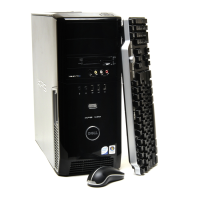Setting Up and Using Your Computer 17
9 USB connectors (2) Use the front USB connectors for devices that you
connect occasionally, such as flash memory keys,
cameras, or bootable USB devices. For more
information on booting to a USB device, see "System
Setup" on page 178.
NOTE: It is recommended that you use the back USB
connectors for devices that typically remain connected,
such as printers and keyboards.
10 headphone connector Use the headphone connector to attach headphones
and most kinds of speakers.
11 microphone connector Use the microphone connector to attach a personal
computer microphone for voice or musical input into
a sound or telephony program.
12 3.5-inch flexbays (2) Can hold an optional Media Card Reader, audio
input, video input, output device with or without a
graphics accelerator device, floppy drive or an
additional hard drive.
13 5.25-inch drive bays (2) Can hold CD-RW/DVD, audio or video input or
output with or without graphics accelerator device,
DVD-RW or Blu-ray Disc™.
14 hard-drive activity light The hard drive light is on when the computer reads
data from or writes data to the hard drive. The light
may also be on when a device such as your CD player
is operating.
15 diagnostic lights(4) Use the sequence of these diagnostics lights to help
troubleshoot a problem with your computer (see
"Dell Diagnostics" on page 86).
16 network indicator light The network link light is on when a good connection
exists between a network and the computer.
17 LCD display Displays a “Now playing” screen for audio and video
applications. Allows you to navigate, select, and
launch devices available on your system.
book.book Page 17 Tuesday, November 27, 2007 10:29 AM

